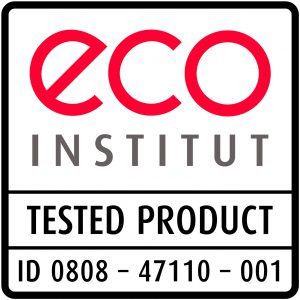 eco-INSTITUT has revised and updated the test criteria for the eco-INSTITUT-Label. The criteria are valid with immediate effect.
eco-INSTITUT has revised and updated the test criteria for the eco-INSTITUT-Label. The criteria are valid with immediate effect.
Since the last revision, some new substance classifications and requirement values have been published, making these adjustments necessary. In addition, concretisations have been made in some places. This allows us to continue to meet the ever-increasing demands placed on healthy living, low-emission and low-pollutant products for interiors and as well as guarantee the high quality of the eco-INSTITUT-Label in the future.
Overview of the changes:
- Based on the GOTS and Ökotex 100 textile labels, the requirements for the pH value for textiles in furniture, bedding and mattresses have been adapted. In addition, the requirements for fastnesses have been revised in line with the GOTS textile label.
- The use of adhesives containing chloroprene is now explicitly permitted for mattresses and furniture, as experience has shown that these adhesives are more advantageous in the overall health assessment compared to technically applicable alternatives that do not contain halogen-organic compounds.
- The scope of the criteria for mineral construction products was specified. Within the scope of this guideline, bricks, stones, plaster, mortar, filler, floor substructures (e.g. screed), insulating materials and similar products made of mineral raw materials as well as screed additives can be certified; floor coverings containing a wear layer fall within the scope of the guideline “Floors and panels based on renewable or mineral carrier materials”.
- Products with a surface intended for indoor exposure fall within the scope of the “Paints and Coatings” guideline. In the future, only products with a minimum share of mineral raw materials of 75 % will be certified in this context.
- The requirements for isocyanates used in sealants, flooring and panels, wood-based materials, adhesives, mineral products, windows, doors, partition walls and furniture have been specified:
- Isocyanates used in the product are only permitted if the final polymerisation takes place in the factory and the product does not release monomeric isocyanates.
- Liquid products containing isocyanate components (labelled EUH204) are not permitted. For background information, please read our pollutant profile post on isocyanates on eco-institut.de.
- The requirement for isothiazolinones has now been added to all liquid products (for sealants, mineral products and adhesives).
- For paints and coatings, adjustments have been made to the heavy metal requirement values.
In the future, it will also be possible to certify products that exceed the requirements, provided that there is proof that the findings are due to the mineral raw materials and that they are naturally occurring impurities. However, compliance with the requirements for eluate analysis is then additionally required.
Harmonisation with the natureplus criteria is being sought. - In all emission requirements, the explicit requirement for styrene (due to the indoor guideline value) was deleted. Due to the IARC classification Group 2A, it belongs to the CMR 1 substances. The requirement for substances in this category is < 1 µg/m³.
- The following classifications were updated in our database due to reclassifications in the corresponding lists at the beginning of the year:
- Propenal (acrolein) upgraded from Group 3 to Group 2A (according to IARC list) (as KMR1 it is now downgraded from 1 µg/m³).
- Aniline got upgraded from Group 3 to Group 2A (according to IARC list) (as KMR1 it is now downgraded from 1 µg/m³)
- 1,4-Dioxane upgraded from Carc. 2 to Carc. 1B (according to IFA list) (as KMR1 it is now downgraded from 1 µg/m³)
- The transition period expires in January 2025.
- Finally, the emission requirement for BIT has been removed from all criteria. This substance cannot be reliably quantified in emission analysis, but the content is determined and assessed in relevant (liquid) products.
- The criteria are valid with immediate effect. If a test for the eco-INSTITUT-Label is commissioned before the new criteria were published, the criteria valid before the change can still be used in the assessment.
At downloads you find all new criteria as PDF documents.
If you have further questions or need more infos on the update of eco-INSTITUT-Label criteria you may contact M.Sc. Environmental Science Vanessa Laumann at Vanessa.Laumann@eco-institut.de.